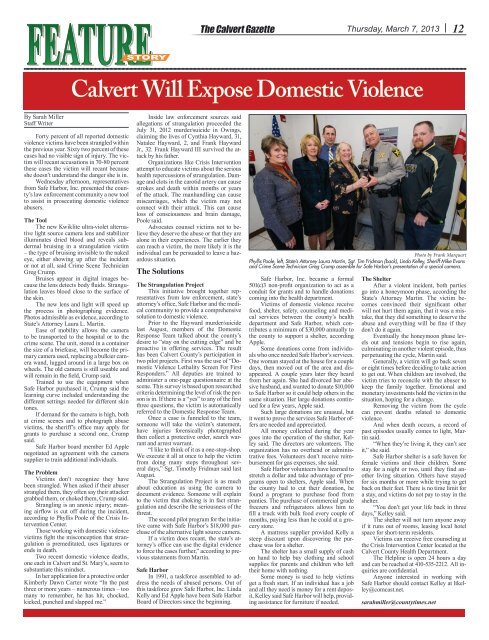Calvert - County Times - Southern Maryland Online
Calvert - County Times - Southern Maryland Online
Calvert - County Times - Southern Maryland Online
Create successful ePaper yourself
Turn your PDF publications into a flip-book with our unique Google optimized e-Paper software.
The <strong>Calvert</strong> Gazette<br />
Thursday, March 7, 2013 12<br />
STORY<br />
<strong>Calvert</strong> Will Expose Domestic Violence<br />
By Sarah Miller<br />
Staff Writer<br />
Forty percent of all reported domestic<br />
violence victims have been strangled within<br />
the previous year. Sixty two percent of these<br />
cases had no visible sign of injury. The victim<br />
will recant accusations in 70-80 percent<br />
these cases the victim will recant because<br />
she doesn’t understand the danger she is in.<br />
Wednesday afternoon, representatives<br />
from Safe Harbor, Inc. presented the county’s<br />
law enforcement community a new tool<br />
to assist in prosecuting domestic violence<br />
abusers.<br />
The Tool<br />
The new Kwiklite ultra-violet alternative<br />
light source camera lens and stabilizer<br />
illuminates dried blood and reveals subdermal<br />
bruising in a strangulation victim<br />
– the type of bruising invisible to the naked<br />
eye, either showing up after the incident<br />
or not at all, said Crime Scene Technician<br />
Greg Crump.<br />
Bruises appear in digital images because<br />
the lens detects body fluids. Strangulation<br />
leaves blood close to the surface of<br />
the skin.<br />
The new lens and light will speed up<br />
the process in photographing evidence.<br />
Photos admissible as evidence, according to<br />
State’s Attorney Laura L. Martin.<br />
Ease of mobility allows the camera<br />
to be transported to the hospital or to the<br />
crime scene. The unit, stored in a container<br />
the size of a briefcase, will become the primary<br />
camera used, replacing a bulkier camera<br />
wand, lugged around in a large box on<br />
wheels. The old camera is still useable and<br />
will remain in the field, Crump said.<br />
Trained to use the equipment when<br />
Safe Harbor purchased it, Crump said the<br />
learning curve included understanding the<br />
different settings needed for different skin<br />
tones.<br />
If demand for the camera is high, both<br />
at crime scenes and to photograph abuse<br />
victims, the sheriff’s office may apply for<br />
grants to purchase a second one, Crump<br />
said.<br />
Safe Harbor board member Ed Apple<br />
negotiated an agreement with the camera<br />
supplier to train additional individuals.<br />
The Problem<br />
Victims don’t recognize they have<br />
been strangled. When asked if their abuser<br />
strangled them, they often say their attacker<br />
grabbed them, or choked them, Crump said.<br />
Strangling is an anoxic injury; meaning<br />
airflow is cut off during the incident,<br />
according to Phyllis Poole of the Crisis Intervention<br />
Center.<br />
Those working with domestic violence<br />
victims fight the misconception that strangulation<br />
is premeditated, uses ligatures or<br />
ends in death.<br />
Two recent domestic violence deaths,<br />
one each in <strong>Calvert</strong> and St. Mary’s, seem to<br />
substantiate this mindset.<br />
In her application for a protective order<br />
Kimberly Dawn Carter wrote “In the past<br />
three or more years – numerous times – too<br />
many to remember, he has hit, chocked,<br />
kicked, punched and slapped me.”<br />
Inside law enforcement sources said<br />
allegations of strangulation proceeded the<br />
July 31, 2012 murder/suicide in Owings,<br />
claiming the lives of Cynthia Hayward, 31,<br />
Natalee Hayward, 2, and Frank Hayward<br />
Jr., 32. Frank Hayward III survived the attack<br />
by his father.<br />
Organizations like Crisis Intervention<br />
attempt to educate victims about the serious<br />
health repercussions of strangulation. Damage<br />
and clots in the carotid artery can cause<br />
strokes and death within months or years<br />
of the attack. The manhandling can cause<br />
miscarriages, which the victim may not<br />
connect with their attack. This can cause<br />
loss of consciousness and brain damage,<br />
Poole said.<br />
Advocates counsel victims not to believe<br />
they deserve the abuse or that they are<br />
alone in their experiences. The earlier they<br />
can reach a victim, the more likely it is the<br />
individual can be persuaded to leave a hazardous<br />
situation.<br />
The Solutions<br />
The Strangulation Project<br />
This initiative brought together representatives<br />
from law enforcement, state’s<br />
attorney’s office, Safe Harbor and the medical<br />
community to provide a comprehensive<br />
solution to domestic violence.<br />
Prior to the Hayward murder/suicide<br />
last August, members of the Domestic<br />
Response Team talked about the county’s<br />
desire to “stay on the cutting edge” and be<br />
proactive in offering services. The result<br />
has been <strong>Calvert</strong> <strong>County</strong>’s participation in<br />
two pilot projects. First was the use of “Domestic<br />
Violence Lethality Screen For First<br />
Responders.” All deputies are trained to<br />
administer a one-page questionnaire at the<br />
scene. This survey is based upon researched<br />
criteria determining the level of risk the person<br />
is in. If there is a “yes” to any of the first<br />
three questions, the victim is automatically<br />
referred to the Domestic Response Team.<br />
Once a case is funneled to the team,<br />
someone will take the victim’s statement,<br />
have injuries forensically photographed<br />
then collect a protective order, search warrant<br />
and arrest warrant.<br />
“I like to think of it as a one-stop-shop.<br />
We execute it all at once to help the victim<br />
from doing many steps throughout several<br />
days,” Sgt. Timothy Fridman said last<br />
August.<br />
The Strangulation Project is as much<br />
about education as using the camera to<br />
document evidence. Someone will explain<br />
to the victim that choking is in fact strangulation<br />
and describe the seriousness of the<br />
threat.<br />
The second pilot program for the initiative<br />
came with Safe Harbor’s $18,000 purchase<br />
of the alternative light source camera.<br />
If a victim does recant, the state’s attorney’s<br />
office can use the digital evidence<br />
to force the cases further,” according to previous<br />
statements from Martin.<br />
Safe Harbor<br />
In 1991, a taskforce assembled to address<br />
the needs of abused persons. Out of<br />
this taskforce grew Safe Harbor, Inc. Linda<br />
Kelly and Ed Apple have been Safe Harbor<br />
Board of Directors since the beginning.<br />
Photo by Frank Marquart<br />
Phyllis Poole, left, State’s Attorney Laura Martin, Sgt. Tim Fridman (back), Linda Kelley, Sheriff Mike Evans<br />
and Crime Scene Technician Greg Crump assemble for Safe Harbor’s presentation of a special camera.<br />
Safe Harbor, Inc. became a formal<br />
501(c)3 non-profit organization to act as a<br />
conduit for grants and to handle donations<br />
coming into the health department.<br />
Victims of domestic violence receive<br />
food, shelter, safety, counseling and medical<br />
services between the county’s health<br />
department and Safe Harbor, which contributes<br />
a minimum of $30,000 annually to<br />
the county to support a shelter, according<br />
Apple.<br />
Some donations come from individuals<br />
who once needed Safe Harbor’s services.<br />
One woman stayed at the house for a couple<br />
days, then moved out of the area and disappeared.<br />
A couple years later they heard<br />
from her again. She had divorced her abusive<br />
husband, and wanted to donate $10,000<br />
to Safe Harbor so it could help others in the<br />
same situation. Her large donations continued<br />
for a few years, Apple said.<br />
Such large donations are unusual, but<br />
it went to prove the services Safe Harbor offers<br />
are needed and appreciated.<br />
All money collected during the year<br />
goes into the operation of the shelter, Kelley<br />
said. The directors are volunteers. The<br />
organization has no overhead or administrative<br />
fees. Volunteers don’t receive reimbursement<br />
for gas expenses, she said.<br />
Safe Harbor volunteers have learned to<br />
stretch a dollar and take advantage of programs<br />
open to shelters, Apple said. When<br />
the county had to cut their donation, he<br />
found a program to purchase food from<br />
panties. The purchase of commercial grade<br />
freezers and refrigerators allows him to<br />
fill a truck with bulk food every couple of<br />
months, paying less than he could at a grocery<br />
store.<br />
A mattress supplier provided Kelly a<br />
steep discount upon discovering the purchase<br />
was for a shelter.<br />
The shelter has a small supply of cash<br />
on hand to help buy clothing and school<br />
supplies for parents and children who left<br />
their home with nothing.<br />
Some money is used to help victims<br />
get a fresh start. If an individual has a job<br />
and all they need is money for a rent deposit,<br />
Kelley said Safe Harbor will help, providing<br />
assistance for furniture if needed.<br />
The Shelter<br />
After a violent incident, both parties<br />
go into a honeymoon phase, according the<br />
State’s Attorney Martin. The victim becomes<br />
convinced their significant other<br />
will not hurt them again, that it was a mistake,<br />
that they did something to deserve the<br />
abuse and everything will be fine if they<br />
don’t do it again.<br />
Eventually the honeymoon phase levels<br />
out and tensions begin to rise again,<br />
culminating in another violent episode, thus<br />
perpetuating the cycle, Martin said.<br />
Generally, a victim will go back seven<br />
or eight times before deciding to take action<br />
to get out. When children are involved, the<br />
victim tries to reconcile with the abuser to<br />
keep the family together. Emotional and<br />
monetary investments hold the victim in the<br />
situation, hoping for a change.<br />
Removing the victim from the cycle<br />
can prevent deaths related to domestic<br />
violence.<br />
And when death occurs, a record of<br />
past episodes usually comes to light, Martin<br />
said.<br />
“When they’re living it, they can’t see<br />
it,” she said.<br />
Safe Harbor shelter is a safe haven for<br />
female victims and their children. Some<br />
stay for a night or two, until they find another<br />
living situation. Others have stayed<br />
for six months or more while trying to get<br />
back on their feet. There is no time limit for<br />
a stay, and victims do not pay to stay in the<br />
shelter.<br />
“You don’t get your life back in three<br />
days,” Kelley said.<br />
The shelter will not turn anyone away<br />
if it runs out of rooms, leasing local hotel<br />
space for short-term residents.<br />
Victims can receive free counseling at<br />
the Crisis Intervention Center located at the<br />
<strong>Calvert</strong> <strong>County</strong> Health Department.<br />
The Helpline is open 24 hours a day<br />
and can be reached at 410-535-2212. All inquiries<br />
are confidential.<br />
Anyone interested in working with<br />
Safe Harbor should contact Kelley at ltkelley@comcast.net.<br />
sarahmiller@countytimes.net

















